Srebrenica
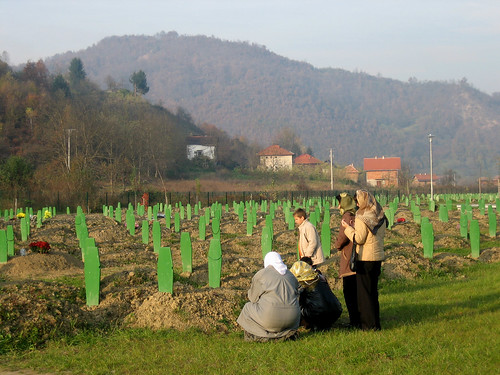
Yesterday I visited Srebrenica, site of one of humanity's worst crimes. During the war, Srebrenica was a Muslim enclave just over the Serbian border which was declared a "UN Safe Area" and "protected" by Dutch peacekeepers. On July 1995, it fell to the Drina Corps of the Serbian Army, under the command of General Ratko Mladic. Serb forces proceeded to massacre approximately 8000 Bosniak males. Mladic is said to have used a special paramilitary unit called "the Scorpions" to perform most of the killing, and a number of Scorpion bit-players are on trial or have been convicted at the Hague. But although Mladic has been indicted for genocide and war crimes, he remains free and in hiding. Radovan Karadzic, the Bosnian Serb political leader, was also indicted for war crimes at Srebrenica and he too remains free and in hiding. He recently released a book of poetry, published by a Serbian company.
It is easier to talk about the visit in pictures:
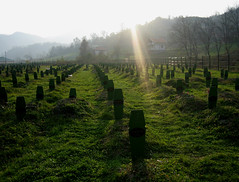
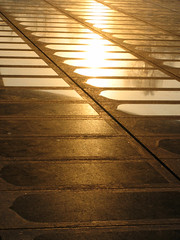
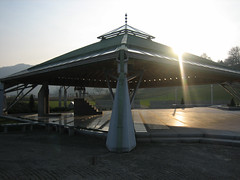
The Srebrenica Memorial is located outside the city, in a town called Potocari. There are roughly 2000 graves at the Memorial, consisting of all identified bodies from the massacre. Enormous warehouses full of unidentified corpses exist north in the town of Tuzla, where the International Committee for Missing Persons continues to analyze remains. Pictured here as well is the quasi-mosque structure at the Memorial, with tiles representing each of the victims.
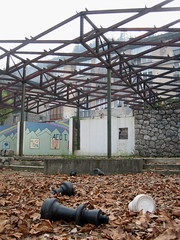 Next we drove to the town itself. Many Bosnian towns have oversized chessboards in their parks. In Sarajevo, they are surrounded all day by crowds of old men. In Srebrenica, the town square is littered with garbage and the chess pieces are scattered.
Next we drove to the town itself. Many Bosnian towns have oversized chessboards in their parks. In Sarajevo, they are surrounded all day by crowds of old men. In Srebrenica, the town square is littered with garbage and the chess pieces are scattered.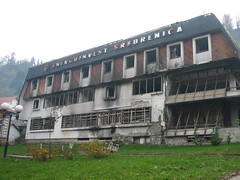
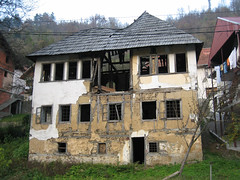
Left: Srebrenica means "silver city," and was once a mining town for the company Energoinvest. Here, the old Energoinvest building lies abandoned and decaying. Right: just another Srebrenican house.
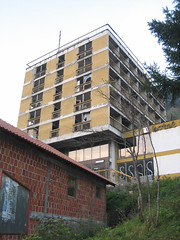
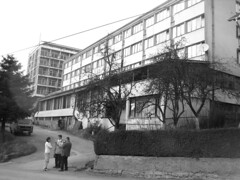
Left: This hotel was called "Hotel Fresh Air" by the locals during the war because of the constantly shattered windows. It is abandoned and, of course, still full of plenty of fresh air. Right: This was the de facto hospital during the war. In front are some journalists doing an interview. They were travelling with a large group of Muslim high school students.
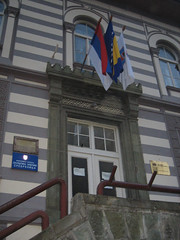
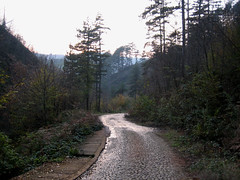
Left: A Serbian flag flies beside a Bosnian and cantonal flag at the UN Development Project headquarters in Srebrenica. Right: This is the mountain road south of town where Dutch UN troops maintained observation posts. Facing the Serbian offensive in July 1995, the Dutch retreated without firing a shot. In 2002, the Dutch government resigned over a report detailing their failure at Srebrenica.
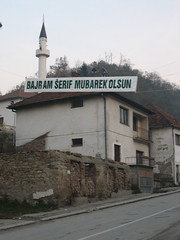
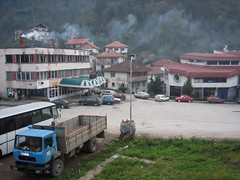
Left: one encouraging sign was the presence of a mosque in Srebrenica, along with a banner wishing a happy Bajram to all. The mosque is counter-balanced by a large Serbian Orthodox Church a couple blocks away. Right: the main square of Srebrenica.
The Memorial was certainly depressing, but at least its very existence can be seen as a positive development. The town of Srebrenica, on the other hand, exudes hopelessness. "Srebrenica" is a name that almost everyone in the West recognizes, and yet its current and former residents must feel completely forgotten. It is a desolate, foul, decaying ghost town.
One of the sad truths of the war is that the ethnic cleansers won. Eastern Bosnia was largely vacated of Muslims, of which Srebrenica is one example. Often the UN was complicit in this, as their mandate was to evacuate the towns for humanitarian reasons. In the end, this was exactly Milosevic's ultimate goal. Srebrenica, once a vibrant Muslim city, is today largely inhabited by Serbs. Before the war, 37,000 people lived in Srebrenica, 73 percent of them Muslim Bosniaks and 23 percent ethnic Serbs. Today, 6,000 Serbs and 4,000 Muslims live there.
On the drive in through the beautiful countryside, we stopped at a gas station where, out of curiosity, I purchased an audiotape with pictures of Mladic and Karadzic on the cover. We of course couldn't understand the lyrics, but it was essentially classic Serbian folk music. Later, as we walked through the town square, I recognized -- though I can't be absolutely sure -- that same style folk music emanating from a cafe where a small crowd had gathered to eat and dance. Anywhere else I might have been encouraged by this small, innocent celebration going on around so much sadness. But in the context of history, I couldn't help feeling nauseous as the cheery tunes echoed through Srebrenica's empty streets like twisted carnival music.

0 Comments:
Post a Comment
<< Home